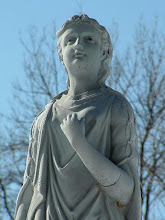This is odd -- everything I read about black locust flowers says they smell very sweet, but I walked up to this one for a sniff and there was no scent. What's up? I must continue my research.

Spot the rabbit hiding in this picture:

It's hiding in a patch of tansy, which I've been busy pulling lately. It's the new garlic mustard. Speaking of garlic mustard, this is what happens after the bolting and flowering stages: those prongs are seed pods full of little black seeds ready to go forth and conquer the world.

While exploring the site I found this artifact, obviously left behind by the early pioneers who settled the area:

I've been reading about
spit bugs, aka spittlebugs or froghoppers. These little insects produce a white froth that hides them and keeps them from drying out while they mature. They've beaten out fleas for the title of
highest jumper in nature, so show a little respect when you see these gobs of spit on your plants.

Sightings: I saw a muskrat in the pond for the first time this season, along with some white-tailed dragonflies. There's been a black-crowned night heron there several times too. Early summer seems to be progressing nicely!
Finally, welcome to a new blog on the block,
Riverdale Farm Ponds Stewardship. Check in there to learn how another great site benefits from the stewardship program.





















































